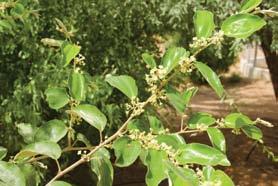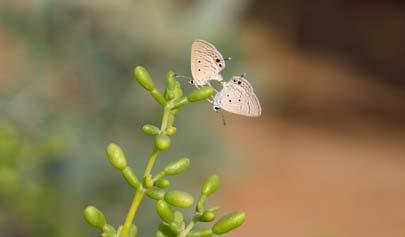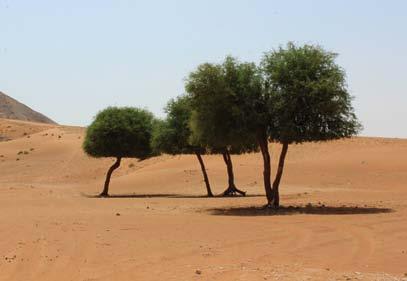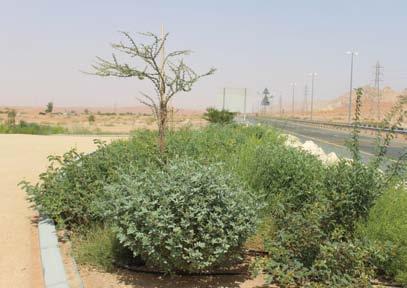
11 minute read
think local
The use of native plant species is on the rise in the UAE but there is still room for improvement
Bruce Pedersen Technical Manager - Landscape Sharjah Investment and Development Authority
Advertisement
By way of some background; as a young horticulturist in South Africa in the mid 1980’s indigenous/ native plants were considered fringe landscape materials; most landscapers didn’t know them, relate to them, know how to use them, or have much interest in using them. Apart from a small dedicated group of nursery men, very few nurseries were even interested in propagating indigenous plants.
Fast forward a few years, extended periods of drought, growing demands on water resources and increasing mandated water restrictions started to drive the industry away from traditional “lush” landscape planting. Local governments and municipalities started to seriously evaluate and legislate changes for plant materials before they were included in the urban landscape. However, one of the pivotal movers to a new landscaping approach was the amount of information that was publicly disseminated through the media
Ziziphus spina-christi is a fruiting naturalised tree Haloxylon sp. in native environment

and environmental agencies. An informed public started to create a demand for native plants which previously did not exist, and remove older, thirsty, and invasive species.
This gave rise to initiatives such as the “Waterwise” program, which does not specifically remove all non-native plant species from the planting palette, but allowed for the integration of selected non-native species with low-water consumption together with an expanded native palette.
These challenges and changes shook up the landscaping and nursery industries; leading to the development (or selection) of new plant materials, rejuvenation and renovation of old landscapes, innovations in the usage of hardscape materials as well as the specialisation by landscapers, designers and irrigation professionals. The Australian landscape industry was faced with and underwent the same metamorphic processes at approximately the same time.
Senna italica flower


Local wildlife and native plants are inter-dependant on each other for their continued survival

Heliotropium curassavicum is an extremely useful groundcover

Prosopis cineraria is found throughout the region
Place this in a regional context of water scarcity and climate.
Ground water supplies are dwindling, or becoming saline, potable water is an expensive overhead on large landscapes. Treated Sewerage Effluent (TSE) water sources are also not infinite; volumes fluctuate seasonally according to incountry population densities and are affected by available physical infrastructure to distribute as well as the increased demand for this resource from competing projects.
The Regional climate of the Middle East does not (yet) seem to be influenced by any macroclimatic shifts related to Climate Change, but the annual norms are extreme. Without the constant reminder of a flourishing green landscape one forgets that much of the region is classified as desert. Therefore, it seems only logical to promote more sustainable forms of landscaping.
Mixed cultivated native planting

what are the biggest challenges when working with native plant species?
Lack of information regarding usage of these species; be that selection, placement, irrigation demands, fertiliser usage or even continued maintenance, to the point that some producers and contractors consider it “proprietary” information.
Lack of actual physical plant materials that are available in the market. I have reviewed dozens of BOQ plant lists over the years calling for the most obscure plant materials that simply don’t exist in the commercial market; this is more prevalent when developers use non-local consultants who seem to use environmental or conservation reports as a source of plant materials.
The average annual rainfall of the UAE is only 120mm (0.32mm of water per day per square meter), this normally occurs during the winter months, but varies from region to region. By comparison, an average square meter of non-native

Mixed planting Zygophyllum, Tephrosia, Senna and Calligonum

Mixed planting of native shrubs and grasses
turf grass receives approximately 12mm of irrigation water per day during midsummer and down to about 8mm during the cooler periods of the year.
How can these challenges be addressed by landscape professionals?
Establish a native plant database, detailing the plant, its specific native habitat, soil requirements, microenvironment, flowering and growth characteristics, seasonality and all importantly water requirements. Even within the broad context of “native” plants, most plants will perform better in situations that are as close to their natural environment as possible.
Develop a suitably mixed palette of native and “waterwise” non-native plants to use, this will serve as an intermediary stage until the palette of usable, native plants is extended and developed. Define the plant palette before starting and find out what is commercially available.
Establish the basic pricing of the plant materials before planning; on average native plant species are going to cost between 4 and 5 times the price of non-native species of the same size specification. This is sometimes a hard sell to a client. This cost is largely due to supply and demand and to recover ongoing R&D costs that are associated with evaluating and propagating new candidate materials; as more and more nurseries start to grow and produce them the unit rate will eventually drop. Native plants can be used in both structured and informal planting designs. Structured simply requires finding the right plant that will provide the characteristic’s and effect in a linear or more formal affect. Informal planting means that you are
Zygophyllum used in informal planting

Mixed planting of native shrubs and grasses


Leptadenia pyrotechnica in production

Young Ziziphus spina-christi
wanting to recreate the informal, diverse planted areas reminiscent of nature. Informal planting relies on the blending on different plant materials in an aesthetically pleasing balance. I often take pictures of native plant groupings that I find in the desert, wadi’s or alongside the road, from this you can determine the plant species, distribution, and ratio of species. This provides a guide or framework to work from when developing a planting scheme.
Determine the type of landscape and planting density required, many native species are going to be slow growing. This means that if only small plant materials are available (which will probably be the case), full cover and density may only be achieved after two or three seasons of growth. What could be done is planting at a higher density, which will increase the per meter cost of the project, or retain the “ideal” planting density, and opt for a slightly less finished installed look until the plants mature.

irrigation options
Establish the water source and budget before starting the design. Most designers follow a bottomup approach, in that they design the landscape and then calculate the water consumption for the site. Reverse this to a top-down methodology, establish a practical water budget first, and see what amount of plants you can afford to use; a simple spreadsheet with quantities, requirements and numbers can help to produce a basic, balanced plant list.
Most native species are more tolerant to higher levels of saline water (or are even halophytic), this opens the door to using saline ground water or blended options to reduce the use of potable or TSE sources.
Mixed informal native planting
Acacia tortilis and Tephrosia in natural environment

Euphorbia larica in its natural environment


Informal native tree and shrub planting
Invest in a good irrigation design and infrastructure. The purpose of using native plants is to reduce water consumption; in their natural habitat many of these species will use up to 25 times less water than non-native contemporaries. A more compartmentalized approach would add more valves, infrastructure, and development costs, but offers more enhanced control in mixed planting areas.
TSE water as a source. It is obvious that the high nutritional content of TSE water has a physiological effect on the growth rate of these plants, resulting in fast, softer growth than would normally be expected in the wild. A common example is the street-side Ghaf trees which are often used in Municipal plantings, based on observations these seem to grow at least 5 times faster than those in the wild.

Euphorbia larica

installing native plants
Plants need to be planted with as much care as possible; considering the costs of these plants this should not be left up to untrained staff. Water the plants well a day or two before planting, it is best to plant when the soil is moist and binds together rather than to have the root system fall apart. Native plants, for the most part is grown in (native) sand; without much fibrous material or compost in the soil mix, the root-ball will be heavy when wet and breaks apart easily. It is almost impossible to remove them from a pot without some form of root damage; the easiest method is to prepare the hole, lie the plant on its side and then slide it out of the pot and then into the ground. If the plants are in bags, the bag can be placed in the planting hole at the correct depth, the bag split and then pulled from beneath the plant.
A word of caution, some species do not transplant very well and have a high mortality rate when planted. In most instances, smaller plants have better rate of survival, and once established are better adjusted than installing large mature plants.
As with most plants, planting depth should be correct, not too deep, and not too shallow. Planting too deeply can result in collar rot, planting too shallow can result in the surface roots being burnt or exposed.
Once planted water well, but sparingly to settle in, ensure that the irrigation system is functional at time of planting. Remember, native plants and will
not tolerate continually waterlogged soils, but will require sufficient moisture to overcome transplant shock and to acclimatize.
The effects of wind cannot be underestimated especially during the autumn and spring; aspect of buildings as well as the time of the year can result in strong winds being funnelled across exposed sites, sometimes removing as much as 10cm of soil per day. Low planting density and the inability to continually dampen the soil can result in the roots of some of the plants being exposed increasing plant losses. In a natural ecosystem plants have to contend with wind, but if you take a close look at a typical desert environment you will see that successful plant materials tend to survive clustered in protected pockets rather than to be found in large numbers on exposed sand dunes. On the positive side, once the plants have established, grasses and those with shallow root systems will ensure that the soil is bound and reduce the amount of wind erosion over a site.
Fertiliser; again, while there are no long-term observations on the use of chemical fertilisers I would suggest that these be kept to a minimum, in their natural habitat most native plants have very little access to any form of fertiliser, with the majority of nutrients coming from decomposing vegetable and animal matter. From experience with South African indigenous plants, artificial chemical fertilisers are strongly avoided as they result in rapid pH and salinity changes to the root zone which due to the lack of organic matter in the soil cannot be adequately buffered. This can cause damage to the root system and affects the plants ability to absorb water.
Maintenance of native plants
Make sure staff are aware which plants are natives and need to be retained, as opposed to ones they simple deem to be “weeds” and remove. Staff who are not used to working with native plants can quickly destroy a native landscape without training and supervision.
Do not clear leaf litter from around the plants, this has a mulching action and decomposes to release nutrients back into the soil; it also helps to bind the soil and reduces the effects of surface wind erosion.
Rouge out unwanted species such as Mesquite and Calotropis which can be invasive when they take hold.
Fast growing grasses can be reduced to one third of their mature height if they start to over grow other plants.
Mixed native planting achieved with a strict water budget

Most native plants prefer a light, formative, irregular styled pruning rather than clipping and hedging, this also provides a more natural aesthetic. Some species are more responsive to formal pruning, Salvadora persica and Aerva javanica, for example make good clipped hedges.
Avoid chemical fertilisers, use slow-release organic fertilisers if necessary.
Check the irrigation system regularly and tweak as required, adjust the system for seasonal fluctuations.
In conclusion, the use of native plants in the local landscape is on the increase, this can be advanced through collaboration between designers and plant producers, sharing of information and resources advances the industry as a whole and provides clients with more sustainable options. Ultimately, the objective is to deliver a solid, low maintenance project within budget to a satisfied client.

UAE East coast, coastal halophytes








